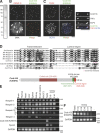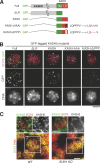A conserved KASH domain protein associates with telomeres, SUN1, and dynactin during mammalian meiosis
- PMID: 22826121
- PMCID: PMC3410425
- DOI: 10.1083/jcb.201204085
A conserved KASH domain protein associates with telomeres, SUN1, and dynactin during mammalian meiosis
Abstract
In yeasts and worms, KASH (Klarsicht/ANC-1/Syne/homology) domain and SUN (Sad-1/UNC-84) domain nuclear envelope (NE) proteins play a crucial role in meiotic chromosome movement and homologue pairing. However, although the vertebrate SUN domain protein SUN1 is involved in these processes, its partner has remained identified. Based on subcellular localization screening in mouse spermatocytes, we identified a novel germ cell-specific protein, KASH5, that localized exclusively at telomeres from the leptotene to diplotene stages in both spermatocytes and oocytes. KASH5 possesses hitherto unknown KASH-related sequences that directly interacted with SUN1 and mediated telomere localization. Thus, KASH5 is a mammalian meiosis-specific KASH domain protein. We show that meiotic chromosome movement depended on microtubules and that KASH5 interacted with the microtubule-associated dynein-dynactin complex. These results suggest that KASH5 connects the telomere-associated SUN1 protein to the cytoplasmic force-generating mechanism involved in meiotic chromosome movement. Our study strongly suggests that the meiotic homologue-pairing mechanism mediated by the SUN-KASH NE bridge is highly conserved among eukaryotes.
Figures





References
Publication types
MeSH terms
Substances
LinkOut - more resources
Full Text Sources
Other Literature Sources
Molecular Biology Databases
Miscellaneous

